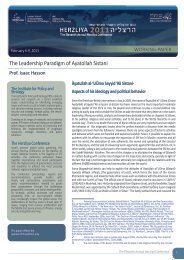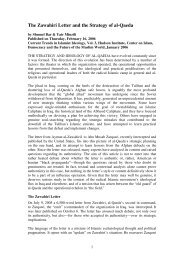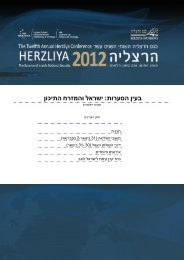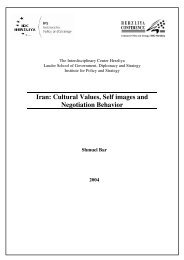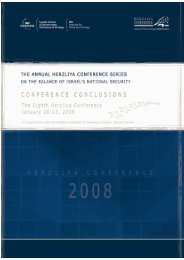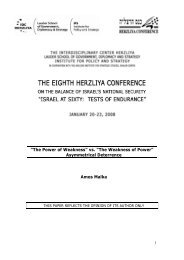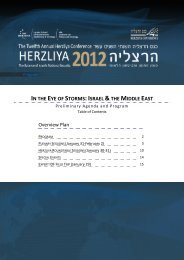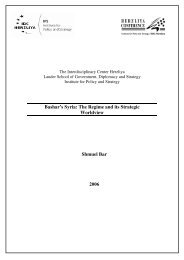Classical Islamic Paradigms of Deterrence and their Expression in ...
Classical Islamic Paradigms of Deterrence and their Expression in ...
Classical Islamic Paradigms of Deterrence and their Expression in ...
You also want an ePaper? Increase the reach of your titles
YUMPU automatically turns print PDFs into web optimized ePapers that Google loves.
Secondly, as we have argued before, deterrence is one <strong>of</strong> the most ancient patterns <strong>of</strong> social organization;it is a policy to <strong>in</strong>fluence group behavior (<strong>in</strong>-groups <strong>and</strong> out-groups); <strong>and</strong> part <strong>of</strong> an <strong>in</strong>st<strong>in</strong>ctive reaction thatresults out <strong>of</strong> the correlation between <strong>in</strong>-group cohesion <strong>and</strong> out-group aggression. 74 <strong>Islamic</strong> traditions onmartial <strong>in</strong>cidents dur<strong>in</strong>g the Sahaba period (the first three generations <strong>of</strong> Muhammad’s followers) stressnumerous cases <strong>in</strong> which the battle spirit <strong>and</strong> resolve <strong>of</strong> Muslim fighters was so overwhelm<strong>in</strong>g that itdeterred the enemy dur<strong>in</strong>g battle. One such <strong>in</strong>stance is the battle <strong>of</strong> Constant<strong>in</strong>ople under the caliphate <strong>of</strong>Mu'awiyya <strong>in</strong> 674 AD. Even though the Theodosian Walls <strong>of</strong> Constant<strong>in</strong>ople proved impregnable dur<strong>in</strong>g thesiege, the s<strong>in</strong>gle attack <strong>of</strong> a Muslim fighter who threw himself <strong>in</strong>to the rows <strong>of</strong> the enemy (<strong>in</strong>ghimas;iqtiham) is said to have had a destructive effect on the Byzant<strong>in</strong>es’ fight<strong>in</strong>g moral:On the strength <strong>of</strong> Abu 'Umran, who told: We were at Constant<strong>in</strong>ople. 'Aqba B<strong>in</strong> 'Amir was <strong>in</strong> charge <strong>of</strong> thepeople from Egypt, <strong>and</strong> a man was <strong>in</strong> charge <strong>of</strong> the people <strong>of</strong> Syria. A powerful division <strong>of</strong> the Byzant<strong>in</strong>es leftthe city. We l<strong>in</strong>ed up towards them. Then, a man from the Muslims launched an attack aga<strong>in</strong>st theByzant<strong>in</strong>es, until he entered <strong>in</strong>to them. Then he returned towards us. The people shouted at him: Praise theLord! He threw himself with his own h<strong>and</strong>s <strong>in</strong>to [his] destruction (tahluka). Then Abu Ayub al-Ansari, thecompanion <strong>of</strong> the prophet <strong>of</strong> Allah, peace <strong>and</strong> bless<strong>in</strong>gs <strong>of</strong> Allah be upon him, raised <strong>and</strong> said: Oh, all <strong>of</strong> youpeople! You <strong>in</strong>terpret this verse with this <strong>in</strong>terpretation (Inna-kum tata'awwalun hadhihi-al-aya 'ala hadha alta'awil).However, this verse was revealed to the community <strong>of</strong> the al-Ansar (ma'shar al-Ansar). When thereligion <strong>of</strong> Allah prospered, <strong>and</strong> its followers grew, some <strong>of</strong> us spoke <strong>in</strong> a small circle <strong>in</strong> secrecy from theprophet, peace <strong>and</strong> bless<strong>in</strong>gs <strong>of</strong> Allah be upon him: Our wealth perished, let’s rebuild it. And we rebuilt whathad perished. Then Allah, the exalted, revealed <strong>in</strong> his book the answer to what we planned. He said: Spendyour money <strong>in</strong> the way <strong>of</strong> The Lord, <strong>and</strong> don’t contribute with your (own) h<strong>and</strong>s to (your) destruction. [(Suratal-Baqara, 2:195) Wa unfuqu fi sabil Allahi wa la talqu bi-ayadikum ila al-tahluka]. And the destruction (altahluka)meant the upheaval (al-qiyama), when we wanted to raise our wealth, <strong>and</strong> rebuild it. He ordered usto raid (fa-'amarana bi-l-rhazu). And Abu Ayub kept on raid<strong>in</strong>g <strong>in</strong> the way <strong>of</strong> Allah until Allah, the exalted,seized him. 75Accord<strong>in</strong>g to the hadith, K 2:195 does not refer to self-destruction, but to a div<strong>in</strong>e revelation for the al-Ansar, 76 which comm<strong>and</strong>ed them to cont<strong>in</strong>ue jihad. Thus, "tahluka" implies that "(self) destruction is theomission <strong>of</strong> jihad". Some Muslim <strong>in</strong>terpreters argue that K 2:195 must not be <strong>in</strong>terpreted <strong>in</strong> a narrowtactical sense, but has a wider strategic <strong>and</strong> ideological implication. And it does not contradict suicidemartyrdomoperations.In the quoted example two deterrence paradigms are aga<strong>in</strong> stalemat<strong>in</strong>g each other. The Theodosian Walls<strong>of</strong> Constant<strong>in</strong>ople posed an impenetrable obstacle (deterrence by denial). Accord<strong>in</strong>g to Muslim traditionthe s<strong>in</strong>gle attack was successful tactic <strong>of</strong> deterrence by punishment, which demoralized the enemy. 77 Thus,the s<strong>in</strong>gle attack example becomes a corner-stone <strong>of</strong> medieval theological deterrence concepts, <strong>and</strong> thencont<strong>in</strong>ues to be important <strong>in</strong> contemporary <strong>Islamic</strong> legal justifications <strong>of</strong> suicide attacks, which arefrequently used by sub-state actors as a form <strong>of</strong> extended deterrence by punishment. Excursus: One might74 The goal is to build-up a coherent <strong>in</strong>-group, at the same time to deter <strong>and</strong> reduce the harmony <strong>of</strong> out-group(s). The correlation between<strong>in</strong>-group harmony <strong>and</strong> out-group aggression is probably one <strong>of</strong> the most basic social behavioral patterns. (trans-species: amongchimpanzees as well as humans) (Demonic Males; Revilla; Jordania).75 Translation by the author. There are different versions <strong>of</strong> this hadith with reference numbers to <strong>their</strong> transmitters, among them: AbuDaw'd (1512), Abu 'Umran with a supposedly sound hadith by the fourth century a.H. Hanafi scholar al-Jasas, al-Tirmidhi (2972), al-Nis'i’s<strong>in</strong>terpretation (48), <strong>and</strong> Ibn 'Atiya <strong>in</strong> "Al-Muharrir al-wajiz", "<strong>in</strong>terpretation <strong>of</strong> the Koran 2/146."76 One <strong>of</strong> two groups <strong>of</strong> Muslims around the Prophet Muhammad after his Hijra (emigration) to Mecca <strong>in</strong> the year 622. The First Groupwere members <strong>of</strong> the Quraysh who emigrated with Muhammad to Mecca, the so-called al-Muhajirun. The second group were people fromMed<strong>in</strong>a who granted Muhammad refuge after the Hijra <strong>and</strong> converted to Islam. Therefore, they ga<strong>in</strong>ed the name "al-Ansar", "the Helpersor Supporters."77 The pr<strong>in</strong>ciple underly<strong>in</strong>g this deterrence/preterrence battle tactic is that constant dropp<strong>in</strong>g wears the stone; but Constant<strong>in</strong>ople only fell<strong>in</strong> 1453.24



